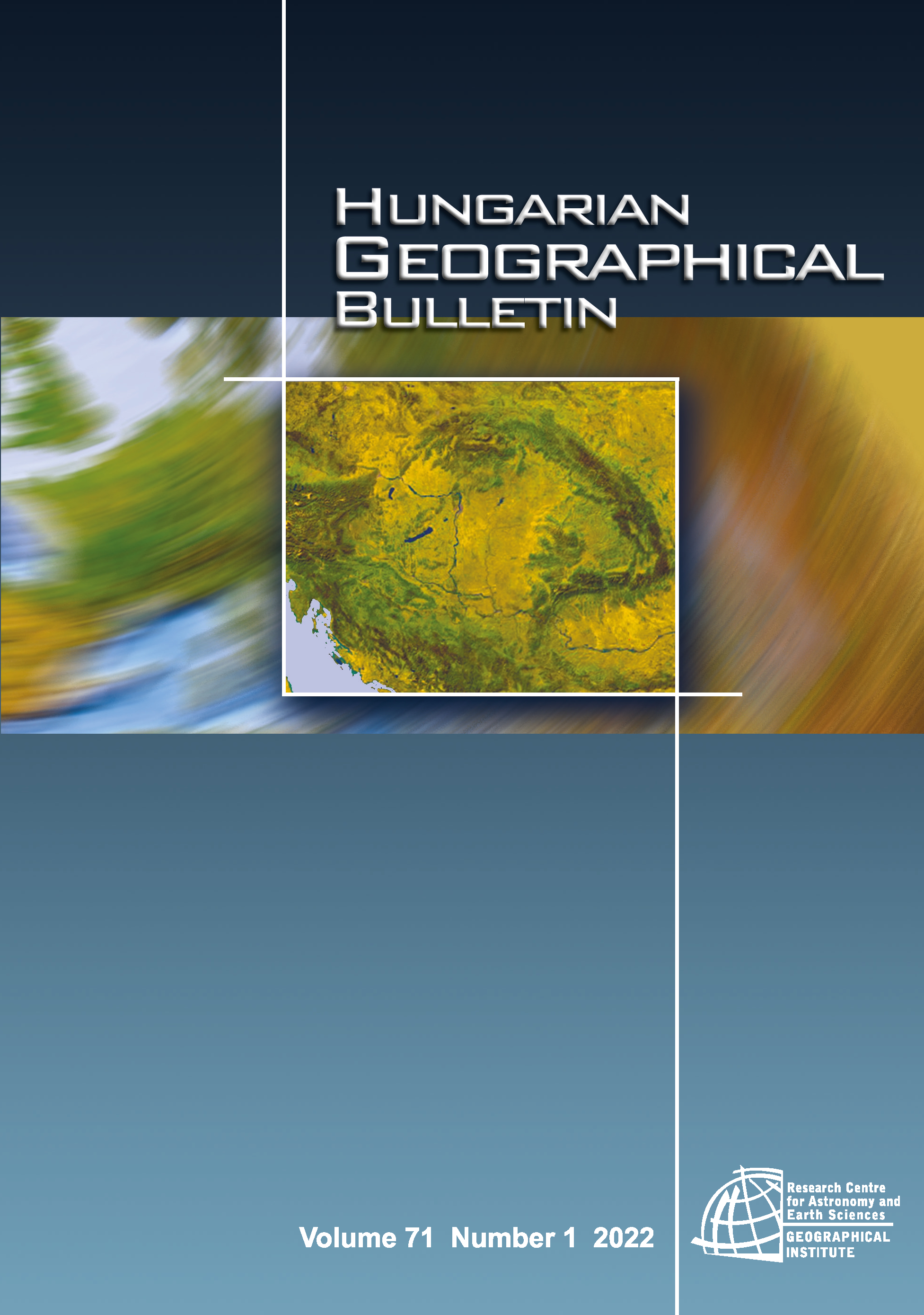Estimating relative sunshine duration from commonly available meteorological variables for simulating biome distribution in the Carpathian Region
Absztrakt
Bright sunshine duration (BSD) data are required for simulating biomes using process-based vegetation models.
However, monthly global paleoclimate datasets that can be used in paleo data–model comparisons do not necessarily contain BSD or radiation data. Considering the theoretical and practical aspects, the scheme of Yin, X. (1999) is here recommended to estimate monthly time series of relative BSD using only monthly climate and location data. As a case study for the Carpathian Region, the efficiency of both the original and a variant of that scheme is analysed in this paper. The alternative scheme has high applicability in paleoenvironmental studies. Comparison of the estimated and observed BSD data shows that from May to August, the value of relative root mean squared error in more than 90 percent of the study area does not exceed the threshold of 20 percent, indicating an excellent performance of the original estimation scheme. It is also found that though the magnitude of overestimation for the alternative algorithm is significant in the winter period, the proposed method performs similarly well in the growing season as the original. Furthermore, concerning modelling the distribution of biomes, simulation experiments are performed to assess the effects of modifying some configuration settings: (a) the generation of relative BSD data, and (b) the algorithm used to create quasi-daily weather data from the monthly values. Under both the recent humidity conditions of the study region and the spatial resolution of the climate dataset used, the results can be considered sufficiently robust, regardless of the configuration settings tested. Thus, using monthly temperature and precipitation climatologies, the spatial distribution of biomes can be properly simulated with the configuration settings proposed here
Hivatkozások
Abatzoglou, J.T., Dobrowski, S.Z., Parks, S.A. and Hegewisch, K.C. 2018. TerraClimate, a high resolution global dataset of monthly climate and climatic water balance from 1958-2015. Scientific Data 5. 170191. https://doi.org/10.1038/sdata.2017.191
Allen, R.G. 1996. Assessing integrity of weather data for reference evapotranspiration estimation. Journal of Irrigation and Drainage Engineering 122. (2): 97-106. https://doi.org/10.1061/(ASCE)0733-9437(1996)122:2(97)
Bellocchi, G., Acutis, M., Fila, G. and Donatelli, M. 2002. An indicator of solar radiation model performance based on a fuzzy expert system. Agronomy Journal 94. (6): 1222-1233. https://doi.org/10.2134/agronj2002.1222
Berger, A. and Loutre, M.F. 1991. Insolation values for the climate of the last 10 million years. Quaternary Science Reviews 10. (4): 297-317. https://doi.org/10.1016/0277-3791(91)90033-Q
Beyer, R.M., Krapp, M. and Manica, A. 2020. High resolution terrestrial climate, bioclimate and vegetation for the last 120,000 years. Scientific Data 7. 236. https://doi.org/10.1038/s41597-020-0552-1
Brock, T.D. 1981. Calculating solar radiation for ecological studies. Ecological Modelling 14. (1-2): 1-19. https://doi.org/10.1016/0304-3800(81)90011-9
Castellvi, F. 2001. A new simple method for estimating monthly and daily solar radiation. Performance and comparison with other methods at Lleida (NE Spain), a semiarid climate. Theoretical and Applied Climatology 69. (3-4): 231-238. https://doi.org/10.1007/s007040170028
Cohen, J. 1960. A coefficient of agreement for nominal scales. Educational and Psychological Measurement 20. (1): 37-46. https://doi.org/10.1177/001316446002000104
Davis, T.W., Prentice, I.C., Stocker, B.D., Thomas, R.T., Whitley, R.J., Wang, H., Evans, B.J., Gallego-Sala, A.V., Sykes, M.T. and Cramer, W. 2017. Simple process-led algorithms for simulating habitats (SPLASH v.1.0): robust indices of radiation, evapotranspiration and plant-available moisture. Geoscientific Model Development 10. (2): 689-708. https://doi.org/10.5194/gmd-10-689-2017
Doorenbos, J. and Pruitt, W.O. 1977. Guidelines for predicting crop water requirements. FAO Irrigation and Drainage Paper No. 24, Technical Report. Rome, Food and Agriculture Organization of the United Nations.
Duffie, J.A. and Beckman, W.A. 1991. Solar Engineering of Thermal Processes. Second Edition. New York, Wiley-Interscience.
Elith, J. and Leathwick, J.R. 2009. Species distribution models: Ecological explanation and prediction across space and time. Annual Review of Ecology, Evolution, and Systematics 40. 677-697. https://doi.org/10.1146/annurev.ecolsys.110308.120159
Epstein, E.S. 1991. On obtaining daily climatological values from monthly means. Journal of Climate 4. (3): 365-368. https://doi.org/10.1175/1520-0442(1991)004<0365:OODCVF>2.0.CO;2
Harris, I., Osborn, T.J., Jones, P. and Lister, D. 2020. Version 4 of the CRU TS monthly high-resolution gridded multivariate climate dataset. Scientific Data 7. 109. https://doi.org/10.1038/s41597-020-0453-3
Harrison, S.P. 2013. Data-Model Comparisons. In Encyclopedia of Quaternary Science. Second Edition. Eds.: Elias, S.A. and Mock, C.J., Amsterdam, Elsevier, 135-146. https://doi.org/10.1016/B978-0-444-53643-3.00007-8
He, F. 2011. Simulating Transient Climate Evolution of the Last Deglaciation with CCSM3. Dissertation, Madison, University of Wisconsin-Madison. Hollis, D., McCarthy, M., Kendon, M., Legg, T. and Simpson, I. 2019. HadUK-Grid - A new UK dataset of gridded climate observations. Geoscience Data Journal 6. (2): 151-159. https://doi.org/10.1002/gdj3.78
Hoyt, D.V. 1977. Percent of possible sunshine and the total cloud cover. Monthly Weather Review 105. (5): 648-652. https://doi.org/10.1175/1520-0493(1977)105<0648:POPSAT>2.0.CO;2
Iqbal, M. 1983. An Introduction to Solar Radiation. London, Academic Press.
Kandirmaz, H.M., Kaba, K. and Avci, M. 2014. Estimation of monthly sunshine duration in Turkey using artificial neural networks. International Journal of Photoenergy 2014. 680596. https://doi.org/10.1155/2014/680596
Kaplan, J.O. 2001. Geophysical Applications of Vegetation Modelling. Dissertation, Lund, Sweden, Lund University.
Karger, D.N., Nobis, M.P., Normand, S., Graham, C.H. and Zimmermann, N.E. (in review) CHELSA-TraCE21k v1.0. Downscaled transient temperature and precipitation data since the last glacial maximum. Climate of the Past Discussion.
Köppen, W. 1936. Das geographische System der Klimate. In Handbuch der Klimatologie. Hrsg.: Köppen, W. und Geiger, R., Berlin, Verlag von Gebrüder Borntraeger, 1-44. (in German)
Krapp, M., Beyer, R.M., Edmundson, S.L., Valdes, P.J. and Manica, A. 2021. A statistics-based reconstruction of high-resolution global terrestrial climate for the last 800,000 years. Scientific Data 8. 228. https://doi.org/10.1038/s41597-021-01009-3
Lüdeke, M.K.B., Badeck, F.W., Otto, R.D., Häger, C., Dönges, S., Kindermann, J., Würth, G., Lang, T., Jäkel, U., ... Kohlmaier, G.H. 1994. The Frankfurt Biosphere Model: A global process-oriented model of seasonal and long-term CO2 exchange between terrestrial ecosystems and the atmosphere. I. Model description and illustrative results for cold deciduous and boreal forests. Climate Research 4. (2): 143-166. https://doi.org/10.3354/cr004143
Mauri, A., Davis, B.A.S., Collins, P.M. and Kaplan, J.O. 2014. The influence of atmospheric circulation on the mid-Holocene climate of Europe: a data-model comparison. Climate of the Past 10. (5): 1925-1938. https://doi.org/10.5194/cp-10-1925-2014
Miller, P.A., Giesecke, T., Hickler, T., Bradshaw, R.H.W., Smith, B., Seppä, H., Valdes, P.J. and Sykes, M.T. 2008. Exploring climatic and biotic controls on Holocene vegetation change in Fennoscandia. Journal of Ecology 96. (2): 247-259. https://doi.org/10.1111/j.1365-2745.2007.01342.x
Phillips, S.J., Anderson, R.P. and Schapire, R.E. 2006. Maximum entropy modelling of species geographic distributions. Ecological Modelling 190. (3-4): 231-259. https://doi.org/10.1016/j.ecolmodel.2005.03.026
Prentice, K.C. 1990. Bioclimatic distribution of vegetation for general circulation model studies. Journal of Geophysical Research: Atmospheres 95. (D8): 11811-11830. https://doi.org/10.1029/JD095iD08p11811
Prentice, I.C., Cramer, W., Harrison, S.P., Leemans, R., Monserud, R.A. and Solomon, A.M. 1992. A global biome model based on plant physiology and dominance, soil properties and climate. Journal of Biogeography 19. (2): 117-134. https://doi.org/10.2307/2845499
Prentice, I.C., Sykes, M.T. and Cramer, W. 1993. A simulation model for the transient effects of climate change on forest landscapes. Ecological Modelling 65. (1-2): 51-70. https://doi.org/10.1016/0304-3800(93)90126-D
Prentice, I.C., Harrison, S.P., Jolly, D. and Guiot, J. 1998. The climate and biomes of Europe at 6000 year BP: comparison of model simulations and pollen-based reconstructions. Quaternary Science Reviews 17. (6-7): 659-668. https://doi.org/10.1016/S0277-3791(98)00016-X
Prentice, I.C., Bondeau, A., Cramer, W., Harrison, S.P., Hickler, T., Lucht, W., Sitch, S., Smith, B. and Sykes, M.T. 2007. Dynamic global vegetation modelling: Quantifying terrestrial ecosystem responses to large-scale environmental change. In Terrestrial Ecosystems in a Changing World. Eds.: Canadell, J.G., Pataki, D.E. and Pitelka, L.F., Berlin and Heidelberg, Springer, 175-192. https://doi.org/10.1007/978-3-540-32730-1_15
Spinoni, J., Szalai, S., Szentimrey, T., Lakatos, M., Bihari, Z., Nagy, A., Németh, Á., Kovács, T., Mihic, D., … Vogt, J. 2015. Climate of the Carpathian Region in the period 1961-2010: Climatologies and trends of 10 variables. International Journal of Climatology 35. (7): 1322-1341. https://doi.org/10.1002/joc.4059
Stanghellini, C. 1981. A simple method for evaluating sunshine duration by cloudiness. Journal of Applied Meteorology and Climatology 20. (3): 320-323. https://doi.org/10.1175/1520-0450(1981)020-0450(1981)020%3C0320:ASMFES%3E2.0.CO;2
Szabóné André, K., Bartholy, J., Pongrácz, R. and Bór, J. 2021. Local identification of persistent cold air pool conditions in the Great Hungarian Plain. Időjárás 125. (2): 167-192. https://doi.org/10.28974/idojaras.2021.2.1
Tapiador, F.J., Moreno, R., Navarro, A., Sánchez, J.L. and García-Ortega, E. 2019. Climate classifications from regional and global climate models: Performances for present climate estimates and expected changes in the future at high spatial resolution. Atmospheric Research 228. 107-121. https://doi.org/10.1016/j.atmosres.2019.05.022
Valdes, P.J., Armstrong, E., Badger, M.P.S., Bradshaw, C.D., Bragg, F., Crucifix, M., Davies-Barnard, T., Day, J.J., Farnsworth, A., … Williams, J.H.T. 2017. The BRIDGE HadCM3 family of climate models: HadCM3@Bristol v1.0. Geoscientific Model Development 10. (10): 3715-3743. https://doi.org/10.5194/gmd-10-3715-2017
Webb, III T., Anderson, K.H., Bartlein, P.J. and Webb, R.S. 1998. Late Quaternary climate change in east ern North America: a comparison of pollen-derived estimates with climate model results. Quaternary Science Reviews 17. (6-7): 587-606. https://doi.org/10.1016/S0277-3791(98)00013-4
Yates, D.N., Kittel, T.G.F. and Cannon, R.F. 2000. Comparing the correlative Holdridge model to mechanistic biogeographical models for assessing vegetation distribution response to climatic change. Climatic Change 44. (1-2): 59-87. https://doi.org/10.1023/A:1005495908758
Yin, X. 1997a. Optical air mass: Daily integration and its applications. Meteorology and Atmospheric Physics 63. (3-4): 227-233. https://doi.org/10.1007/BF01027387
Yin, X. 1997b. Calculating daytime mean relative air mass. Agricultural and Forest Meteorology 87. (2-3): 85-90. https://doi.org/10.1016/S0168-1923(97)00029-4
Yin, X. 1998. The albedo of vegetated land surfaces: Systems analysis and mathematical modelling. Theoretical and Applied Climatology 60. (1-4): 121-140. https://doi.org/10.1007/s007040050038
Yin, X. 1999. Bright sunshine duration in relation to precipitation, air temperature and geographic location. Theoretical and Applied Climatology 64. (1-2): 61-68. https://doi.org/10.1007/s007040050111
Copyright (c) 2022 Zoltán Szelepcsényi, Hajnalka Breuer, Nándor Fodor

This work is licensed under a Creative Commons Attribution-NonCommercial-NoDerivatives 4.0 International License.






